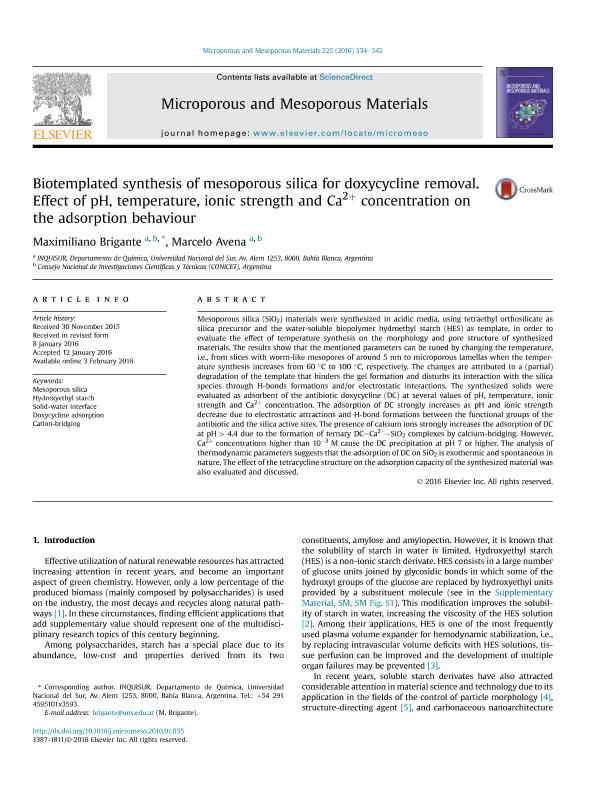Mostrar el registro sencillo del ítem
dc.contributor.author
Brigante, Maximiliano Eduardo

dc.contributor.author
Avena, Marcelo Javier

dc.date.available
2018-08-08T16:26:40Z
dc.date.issued
2016-05-01
dc.identifier.citation
Brigante, Maximiliano Eduardo; Avena, Marcelo Javier; Biotemplated synthesis of mesoporous silica for doxycycline removal. Effect of pH, temperature, ionic strength and Ca2+ concentration on the adsorption behaviour; Elsevier Science; Microporous and Mesoporous Materials; 225; 1-5-2016; 534-542
dc.identifier.issn
1387-1811
dc.identifier.uri
http://hdl.handle.net/11336/54586
dc.description.abstract
Mesoporous silica (SiO2) materials were synthesized in acidic media, using tetraethyl orthosilicate as silica precursor and the water-soluble biopolymer hydroethyl starch (HES) as template, in order to evaluate the effect of temperature synthesis on the morphology and pore structure of synthesized materials. The results show that the mentioned parameters can be tuned by changing the temperature, i.e., from slices with worm-like mesopores of around 5 nm to microporous lamellas when the temperature synthesis increases from 60 °C to 100 °C, respectively. The changes are attributed to a (partial) degradation of the template that hinders the gel formation and disturbs its interaction with the silica species through H-bonds formations and/or electrostatic interactions. The synthesized solids were evaluated as adsorbent of the antibiotic doxycycline (DC) at several values of pH, temperature, ionic strength and Ca2+ concentration. The adsorption of DC strongly increases as pH and ionic strength decrease due to electrostatic attractions and H-bond formations between the functional groups of the antibiotic and the silica active sites. The presence of calcium ions strongly increases the adsorption of DC at pH > 4.4 due to the formation of ternary DC-Ca2+-SiO2 complexes by calcium-bridging. However, Ca2+ concentrations higher than 10-3 M cause the DC precipitation at pH 7 or higher. The analysis of thermodynamic parameters suggests that the adsorption of DC on SiO2 is exothermic and spontaneous in nature. The effect of the tetracycline structure on the adsorption capacity of the synthesized material was also evaluated and discussed.
dc.format
application/pdf
dc.language.iso
eng
dc.publisher
Elsevier Science

dc.rights
info:eu-repo/semantics/openAccess
dc.rights.uri
https://creativecommons.org/licenses/by-nc-sa/2.5/ar/
dc.subject
Cation-Bridging
dc.subject
Doxycycline Adsorption
dc.subject
Hydroxyethyl Starch
dc.subject
Mesoporous Silica
dc.subject
Solid-Water Interface
dc.subject.classification
Otras Ciencias Químicas

dc.subject.classification
Ciencias Químicas

dc.subject.classification
CIENCIAS NATURALES Y EXACTAS

dc.title
Biotemplated synthesis of mesoporous silica for doxycycline removal. Effect of pH, temperature, ionic strength and Ca2+ concentration on the adsorption behaviour
dc.type
info:eu-repo/semantics/article
dc.type
info:ar-repo/semantics/artículo
dc.type
info:eu-repo/semantics/publishedVersion
dc.date.updated
2018-08-01T14:28:00Z
dc.journal.volume
225
dc.journal.pagination
534-542
dc.journal.pais
Países Bajos

dc.journal.ciudad
Amsterdam
dc.description.fil
Fil: Brigante, Maximiliano Eduardo. Consejo Nacional de Investigaciones Científicas y Técnicas. Centro Científico Tecnológico Conicet - Bahía Blanca. Instituto de Química del Sur. Universidad Nacional del Sur. Departamento de Química. Instituto de Química del Sur; Argentina
dc.description.fil
Fil: Avena, Marcelo Javier. Consejo Nacional de Investigaciones Científicas y Técnicas. Centro Científico Tecnológico Conicet - Bahía Blanca. Instituto de Química del Sur. Universidad Nacional del Sur. Departamento de Química. Instituto de Química del Sur; Argentina
dc.journal.title
Microporous and Mesoporous Materials

dc.relation.alternativeid
info:eu-repo/semantics/altIdentifier/url/https://www.sciencedirect.com/science/article/pii/S1387181116000652
dc.relation.alternativeid
info:eu-repo/semantics/altIdentifier/doi/http://dx.doi.org/10.1016/j.micromeso.2016.01.035
Archivos asociados
